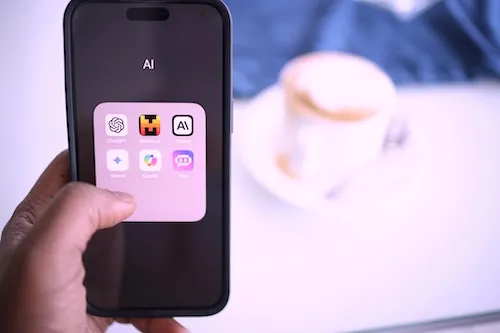Zero Click Searches and AI Chatbots: Winning Search Strategy for Ecommerce Brands

Chatbot results and zero click searches are becoming more important for ecommerce brands. A zero click search is a query where the user gets the answer they were searching for without clicking anything else. For example, if the user asks ‘what movies are showing at my local theatre’ Google will pull up showtimes. If they ask for the weather in New Jersey, they’ll get a forecast – all without scrolling down into the results.
Search situations become more complex as the number of queries that can be ‘zero clicked’ increase. Today, featured snippets, knowledge panels, “People Also Ask” boxes, and AI overviews can all answer users' questions without leaving the search page. Queries like “What time is it in Jamaica?” “Who was in Glengarry Glen Ross?” “What time is the football game?” can all be answered directly, and likely zero clicked.
The same goes for AI chatbots and platforms like Perplexity AI, which let the user ask a question, purchase products, and even check out in the same place. AI platforms and chatbots are quickly gobbling up more users – and search share. So how can you tailor your online presence to these new forms of search? Here are a few insights:
How do zero click searches and AI chatbots impact your ecommerce brand?
Do users actually trust zero-click search? It depends on the query. Something like, “What is the weather like in Hawaii?” is probably answered right in Google, but “How to stop your hair from getting frizzy in Hawaii” will be an AI overview.

Depending on the user, they’ll “zero click” the former, and skim past the overview to get a fuller perspective in the latter. Why? There's no one right answer, and the user probably knew about this ambiguity before performing the search, hence the plethora of YouTube videos recommended in results. What does the average person want from this query? Advice and tips from people who have hair similar to theirs – which means they aren’t necessarily going to stay on Google.
Some variance has more to do with the user themselves. The fairweather bracket-maker Googles “March Madness” and zero clicks the score, while a college basketball die-hard might dig into even low-ranked results for the latest news. In any case, there’s some pretty good search volume around turning these overviews off (and only one real solution, adding a few curse words to your search!).
On the whole, though, zero click searches are an accelerating trend. You can’t stop Google from showing users zero click results, but you can adapt your strategy. Targeting zero click searches like featured snippets or map packs (the three highest ranked results in your local area or “near me”) is probably worth the effort. Trying to appear in every AI overview might not.
Creating keyword strategy for zero click searches and AI chatbots
For those AI overviews, Google provides its answers by pulling data from third-party sources – like your brand. Normal SEO best practices still apply, including clear formatting, active voice, and expertise. Break content into smaller sections, use short paragraphs, and tell the platform what the data means with schema markup. Google has a Data Markup Helper, which helps you input a page (your website) and add microdata like the product’s name, price, availability, and any reviews, star ratings, or discounts.
The same (sort of) goes for chatbot queries like those made to Perplexity.ai and ChatGPT. In addition to search engine schema, which help the LLM understand what your website is about and where the information is held, AI platforms generally search like humans. Since LLMs are trained on hundreds of thousands of pieces of human generated data, the search queries they use to answer a question will look a lot like human search terms.
Keep in mind that if you’d like to know how a certain model sources data In practice, you can ask it! Best practice: verify these insights by asking questions relevant to your brand. Here, in an example with ChatGPT, ranking seems to include:
- Relevance (precise information like dates and times, availability of pdfs or tables with visual information for any data-related questions)
- Specialization (ie. a site dedicated only to Hawaii travel)
- Avoiding “clutter, popups, or ambiguous phrasing”, which seems to support investing in proper schema markup
- A bias towards verified, official, or known data accuracy (and public trust)
For shopping, the process appears to be similar – and a little bit familiar to anyone who has dealt in SEO for a long time. The models seem to prioritize verbatim answers for queries, as well as consumer reviews, actual field tests, expert opinions, and recent updates.
In another shopping example, I questioned the rationale behind suggestions for “custom children’s hats.” The LLM suggested that it:
- Reviewed the top 20-30 results for the location
- Chose sites that clearly offered a custom option, including visualization tools, like “customization interfaces or order examples”
- Chose sites that had clear shipping info, prices, and personalization details
It appeared to deprioritize dropship-heavy marketplaces like Etsy, retailers outside my location, and generic blog posts or possibly fake stores.
Creating a Winning AI Chatbot and Search Strategy in 2025
As search shifts (slightly) towards AI-chatbots and zero-click queries, it’s important to create an “all in one” strategy for your brand. Search is no longer as centralized, and would-be buyers are surfing YouTube, TikTok, Amazon, and Reddit, in addition to using zero-click searches and chatbots. Ultimately, though, the goal remains the same: developing a strong relationship with your customer, and understanding both them and your brand.




